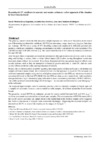Identificador persistente para citar o vincular este elemento:
https://accedacris.ulpgc.es/jspui/handle/10553/114792
| Título: | Benzotriazole UV stabilizers in seawater and marine sediments: a first approach of the situation in Gran Canaria island | Autores/as: | Montesdeoca Esponda, Sarah Sosa Ferrera, María Zoraida Santana Rodríguez, José Juan |
Clasificación UNESCO: | 2510 Oceanografía 251001 Oceanografía biológica 251002 Oceanografía química 330811 Control de la contaminación del agua |
Fecha de publicación: | 2014 | Conferencia: | IV Congress of Marine Sciences | Resumen: | The growing concern about the link between sunlight exposure and skin cancer has led to an increased use of Benzotriazole ultraviolet stabilisers (BUVSs) in sunscreens, soaps, shampoos, lip gloss, hair dyes and makeup. BUVSs are a group of UV absorbing compounds employed in different personal care products, which are considered emerging contaminants that reflect and absorb the solar radiation (UVA 320-400 nm and UVB 290–320 nm). The usual concentration of UV filters in cosmetics is between 0.1 and 10%. After be used, these compounds can reach the environment through recreational activities such as swimming and bathing in oceans, lakes or rivers (direct inputs) or after passing throughout wastewater treatment plants without be removed. It has been demonstrated that can present negative effects over aquatic systems, such as they are mutagenic in bacterial systems and toxic in plants, and can exert adverse effects on the fecundity and reproduction of fish. Despite this, no information is available regarding the contamination of these pollutants in environmental samples of Gran Canaria Island. We evaluated for first time the presence of seven BUVSs in liquid and solid environmental samples using on-line solid-phase extraction (On-line SPE) and microwave-assisted extraction followed by On-line SPE (MAE-On-line SPE) as clean up step, respectively, both coupled to ultra-performance liquid chromatography with tandem mass spectrometry detection (UHPLC-MS/MS). The LODs achieved were in the range of 0.9-4.4 ng L−1 in seawater and between 53.3 and 106 ng kg−1 in the sediments. The analysed liquid samples were 12 seawater samples while we selected 3 samples of beach sand and 4 samples of sediments close to a marine outfall as solid samples, all of them around the Gran Canaria Island. We quantified several BUVSs in sediments around the marine outfall between 0.18 and 24.0 ng g−1, while no compound was detected in the beach sand samples. The concentrations of BUVSs measured in the outfall marine sediments are higher closer to the outfall than in the farthest sample, which suggests that there is a dispersion of analytes from wastewater discharged. Regarding the seawater samples, we detected two BUVs in most of the beaches, in the range 2.8–5.2 ng L−1. | URI: | https://accedacris.ulpgc.es/handle/10553/114792 | ISBN: | 84-697-0471-0 | Fuente: | Book of Abstracts submitted to the IV Congress of Marine Sciences. Las Palmas de Gran Canaria, June 11th to 13th 2014, p. 122 |
| Colección: | Actas de congresos |
Visitas
19
actualizado el 11-ene-2026
Descargas
3
actualizado el 11-ene-2026
Google ScholarTM
Verifica
Altmetric
Comparte
Exporta metadatos
Los elementos en ULPGC accedaCRIS están protegidos por derechos de autor con todos los derechos reservados, a menos que se indique lo contrario.
